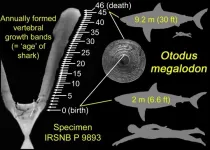(Press-News.org) Fieldwork led by Dr Eleanor Scerri, head of the Pan-African Evolution Research Group at the Max Planck Institute for the Science of Human History in Germany and Dr Khady Niang of the University of Cheikh Anta Diop in Senegal, has documented the youngest known occurrence of the Middle Stone Age. This repertoire of stone flaking methods and the resulting tools includes distinctive ways of producing sharp flakes by carefully preparing nodules of rock, some of which were sometimes further shaped into tool forms known as 'scrapers' and 'points.' Middle Stone Age finds most commonly occur in the African record between around 300 thousand and 30 thousand years ago, after which point they largely vanish.
It was long thought that these tool types were replaced after 30 thousand years ago by a radically different, miniaturized toolkit better suited to diversified subsistence strategies and patterns of mobility across Africa. In a paper published in Scientific Reports this week, Scerri and colleagues show that groups of hunter-gatherers in what is today Senegal continued to use Middle Stone Age technologies associated with our species' earliest prehistory as late as 11 thousand years ago. This contrasts with the long-held view that humanity's major prehistoric cultural phases occurred in a neat and universal sequence.
The 'Last Eden'?
"West Africa is a real frontier for human evolutionary studies - we know almost nothing about what happened here in deep prehistory. Almost everything we know about human origins is extrapolated from discoveries in small parts of eastern and southern Africa," says Dr Eleanor Scerri, the lead author of the study.
To redress this gap in the data, Scerri and Niang put together a research program to explore different regions of Senegal. The program ranges from Senegal's desert edges to its forests and along different stretches of its major river systems: the Senegal and the Gambia, where they found multiple Middle Stone Age sites, all with surprisingly young dates.
"These discoveries demonstrate the importance of investigating the whole of the African continent, if we are to really get a handle on the deep human past." says Dr Khady Niang. "Prior to our work, the story from the rest of Africa suggested that well before 11 thousand years ago, the last traces of the Middle Stone Age - and the lifeways it reflects - were long gone."
Explaining why this region of West Africa was home to such a late persistence of Middle Stone Age culture is not straightforward.
"To the north, the region meets the Sahara Desert," explains Dr Jimbob Blinkhorn, one of the paper's authors. "To the east, there are the Central African rainforests, which were often cut off from the West African rainforests during periods of drought and fragmentation. Even the river systems in West Africa form a self-contained and isolated group."
"It is also possible that this region of Africa was less affected by the extremes of repeated cycles of climate change," adds Scerri. "If this was the case, the relative isolation and habitat stability may simply have resulted in little need for radical changes in subsistence, as reflected in the successful use of these traditional toolkits."
"All we can be sure about is that this persistence is not simply about a lack of capacity to invest in the development of new technologies. These people were intelligent, they knew how to select good stone for their tool making and exploit the landscape they lived in," says Niang.
An ecological, biological and cultural patchwork
The results fit in with a wider, emerging view that for most of humanity's deep prehistory, populations were relatively isolated from each other, living in subdivided groups in different regions.
Accompanying this striking finding is the fact that in West Africa, the major cultural shift to more miniaturized toolkits also occurs extremely late compared to the rest of the continent. For a relatively short time, Middle Stone Age using populations lived alongside others using the more recently developed miniaturized tool kits, referred to as the 'Later Stone Age'.
"This matches genetic studies suggesting that African people living in the last ten thousand years lived in very subdivided populations," says Dr Niang. "We aren't sure why, but apart from physical distance, it may be the case that some cultural boundaries also existed. Perhaps the populations using these different material cultures also lived in slightly different ecological niches."
Around 15 thousand years ago, there was a major increase in humidity and forest growth in central and western Africa, that perhaps linked different areas and provided corridors for dispersal. This may have spelled the final end for humanity's first and earliest cultural repertoire and initiated a new period of genetic and cultural mixing.
"These findings do not fit a simple unilinear model of cultural change towards 'modernity'," explains Scerri. " Groups of hunter-gatherers embedded in radically different technological traditions occupied neighbouring regions of Africa for thousands of years, and sometimes shared the same regions. Long isolated regions, on the other hand, may have been important reservoirs of cultural and genetic diversity," she adds. "This may have been a defining factor in the success of our species."
INFORMATION:
Researchers have taken an important step forward in developing a controlled human infection model to test leishmaniasis vaccines.
The University of York-led study identified and characterised a new strain of Leishmania parasite that will form the basis of a new controlled human infection model for the disease which is transmitted by the bite of sand flies. The team then produced the parasite to the standards required for use in human clinical studies.
The use of controlled human infection models has already proved invaluable in accelerating vaccine development for cholera, malaria, typhoid, ...
Conditions are ripe for transforming the U.S. mental health care system, with scientific advances, the growth of Medicaid and political consensus on the importance of improving mental health creating the possibility that goals once thought out of reach may be possible, according to a new RAND Corporation study.
Broad changes will be needed to improve how Americans receive mental health care, such as integrating behavioral health care into general health care settings, providing supportive housing to the homeless and promoting comprehensive mental health education.
Federal mental health parity legislation is one recent promising development that aims to put ...
Human papillomavirus (HPV) can infect the mouth and throat to cause cancers of the oropharynx. A new study published early online in END ...
Canada must dismantle anti-Black racism in health care to address its harmful effects on people's health, argue authors of a commentary in CMAJ (Canadian Medical Association Journal)
http://www.cmaj.ca/lookup/doi/10.1503/cmaj.201579
Racism has significant negative effects on the physical and mental health of Black people and people of nondominant racial groups. For example, there have been significantly higher death rates from COVID-19 among Black people in North America and the United Kingdom. Anti-Black racism also exists in the medical system, with stereotyping and bias by health care providers and an underrepresentation of Black physicians.
"First, we who work in health care must acknowledge the existence of anti-Black racism in ...
An analysis of a large nationally representative longitudinal study by University of California San Diego Herbert Wertheim School of Public Health and Human Longevity Science report that starting tobacco products, including e-cigarettes, before the age of 18 is a major risk factor for people becoming daily cigarette smokers.
Reporting in the January 11, 2021 online edition of Pediatrics, researchers found that in 2014 people age 12 to 24 who used e-cigarettes were three times as likely to become daily cigarette smokers in the future. Among those who reported using a tobacco product, daily use increased with age through age 28. Daily cigarette smoking nearly doubled between 18 to 21 year olds (12 percent) and 25 to 28 year ...
Marijuana use increases throughout the calendar year, with use up 13 percent on average at the end of each year (2015-2019) compared to the beginning, according to a new study published in the journal Drug and Alcohol Dependence.
"We found that marijuana use is consistently higher among those surveyed later in the year, peaking during late fall or early winter before dropping at the beginning of the following year. We think this may be due, in part, to a 'Dry January' in which some people stop drinking alcohol or even stop using marijuana as part of a New Year's ...
The gut plays a central role in the regulation of the body's metabolism and its dysfunction is associated with a variety of diseases, such as obesity, diabetes, colitis and colorectal cancer that affect millions of people worldwide. Targeting endocrine dysfunction at an early stage by stimulating the formation of specific enteroendocrine cells from intestinal stem cells could be a promising regenerative approach for diabetes therapy. For this, however, a detailed understanding of the intestinal stem cell lineage hierarchy and the signals regulating the recruitment of the different intestinal cell types is critical.
Heiko Lickert ...
How the larvae of colorful clownfish that live among coral reefs in the Philippines are dispersed varies widely, depending on the year and seasons - a Rutgers-led finding that could help scientists improve conservation of species.
Right after most coral reef fish hatch, they join a swirling sea of plankton as tiny, transparent larvae. Then currents, winds and waves disperse them, frequently to different reefs.
During seven years of surveys of coral reef-dwelling clownfish, scientists measured how the dispersal of larvae varied over the years and seasonally, including during monsoons, according Rutgers-led research in the journal Molecular Ecology. They found that larvae dispersal varied a lot on both timescales.
Their research suggests that when scientists ...
A new study shows that the gigantic Megalodon or megatooth shark, which lived nearly worldwide roughly 15-3.6 million years ago and reached at least 50 feet (15 meters) in length, gave birth to babies larger than most adult humans.
This latest research shedding light on the reproductive biology, growth and life expectancy of Megalodon (formally called Otodus megalodon) appears in the international journal Historical Biology.
Although Otodus megalodon is typically portrayed as a super-sized, monstrous shark in novels and films such as the 2018 sci-fi film "The Meg," scientific data support a more modest but still impressive estimate of about 50 feet (15 meters) for the presently known largest individuals. The ...
Positive "tipping points" could spark cascading changes that accelerate action on climate change, experts say.
A tipping point is a moment when a small change triggers a large, often irreversible, response.
Professor Tim Lenton, Director of the Global Systems Institute (GSI) at the University of Exeter, has previously warned the world is "dangerously close" to several tipping points that could accelerate climate change.
But in a new paper in the journal Climate Policy, Professor Lenton and Simon Sharpe, a Deputy Director in the UK Cabinet Office COP 26 unit, identify tipping points in human societies that could rapidly ...




